Lieutenant Reginald Herbert Verry: 9th / 49th Battalion
By JOL Admin | 9 September 2015
Guest blogger: Ian Lang, researcher, Coorparoo Methodist Church Roll of Honour
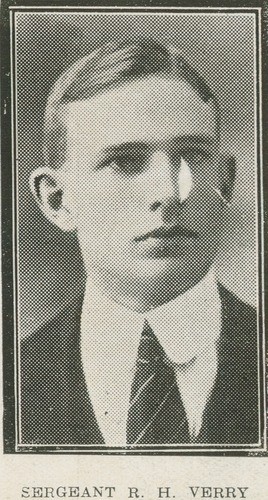
Sergeant R.H. Verry, in The Queenslander Pictorial, supplement , 1915
The story of Reg Verry is closely linked to that of another soldier whose name appears on the Coorparoo Memorial, James Atkinson. Although coming from different backgrounds their war service runs in very close parallel, with similarities in age, rank, battalions, and most importantly an apparent friendship which resulted in Reg marrying James’s sister Vera.
Few facts are available regarding Reg’s early life as a Roll of Honour circular was not completed after his death. From his attestation papers, it is apparent that he was born in Toowoomba in 1894, and prior to enlistment worked as a clerk. He gave his home address as Yangan via Warwick and listed his mother at the same address as his next of kin. Reg’s mother had remarried with the surname of Gamack so it can be assumed that Reg’s father was deceased. He had at least one other sibling, brother Alfred who was two years younger. Reg reported that in spite of his youth (19 years old) he had two years experience with the 11th Infantry Battalion Citizens Forces based in Toowoomba.
Reg presented himself for enlistment at Toowoomba on 21st August 1914, probably the first day that recruiting opened in the city. He was drafted as a private into the 9th after enlisting and one week later, sergeant.
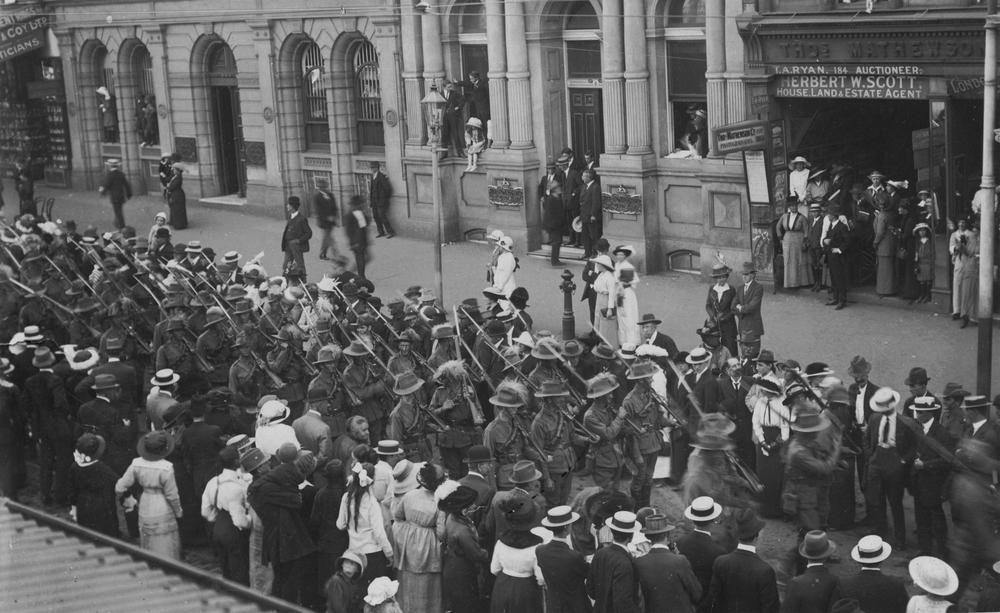
9th Battalion A.I.F. marching through Queen Street Brisbane 1914
One month after Reg’s enlistment, the 9th Battalion, after parading through the streets of Brisbane, boarded HMAT “Omrah” bound for Melbourne. The battalion disembarked from their transport and spent from the 1st to the 16th of October in training, probably with the other battalions of the 3rd Brigade. On the 17th October, the battalion was inspected on the Melbourne Town Pier by Prime Minister Andrew Fisher (who had famously pledged to “defend the empire to the last man and last shilling” during the election campaign of 1914) and the Minister of Defence, Senator George Pearce. The Battalion then re-embarked on the “Omrah” and sailed for King George Sound, Albany to rendezvous with the rest of the first division transports before sailing for Egypt via Colombo, Aden, Suez and Port Said.
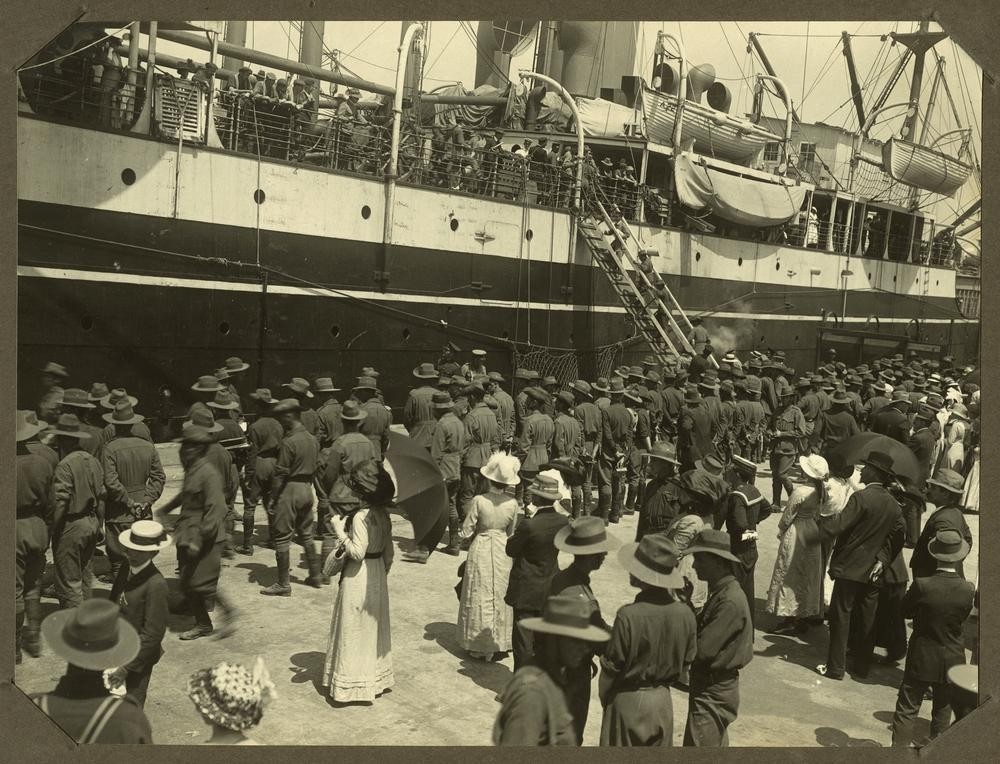
Queensland troops leaving on the ship Omrah for service in the First World War 1914
It is highly probable that during the time spent in training and at sea that Reg struck up a friendship with James Atkinson. They were of a similar age, had similar experiences with the Citizens Forces and were both sergeants. By March 1915, training had been completed and the 9th sailed for Lemnos where they were in camp whilst practising boat drills for the landings at Anzac.
The plan for the landing of 25 April called for the 3rd Brigade to land first as the covering force with the 9th Battalion on the far right, closest to the artillery batteries around Gaba Tepe. During the landing on the 25th April, Reg Verry received a gunshot wound to the left shoulder and he was evacuated to Cairo, arriving as one of the first casualties at the #1 Australian General Hospital on 30 April.
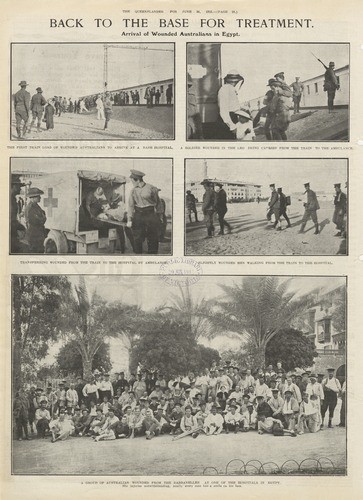
Page 28 of the Queenslander Pictorial supplement to The Queenslander 26 June 1915
The bullet had lodged in the head of Reg’s left humerus and medical opinion was that it would be advisable to leave it in place. Massage was recommended. In June 1915 a Medical Board convened in Cairo considered Reg’s case and recommended he be invalided back to Australia for a “change”. On 5th July 1915 Reg boarded the “Ballarat” at Suez and arrived in Melbourne on 6th August.
It is likely that Reg returned to Toowoomba or Warwick to fully recover but by January 1916, Reg had returned to duty with the 1st Military District in Brisbane, and was promoted to 2nd Lieutenant on 16th June. It was probably at this time that Reg made contact with the family of his friend James Atkinson who lived at “Martha Villi”, Cavendish Road, Coorparoo.
The Atkinson family at that time; headed by Henry Wallace Atkinson, a prominent architect in the city, also included James’ younger sister Vera. The Brisbane Courier of 30th September 1916 reported gushingly of the Military Wedding of 2nd Lieutenant Reginald Verry to Miss Vera Atkinson at the Saint Philip’s Church of England, Thompson Estate (now Cornwall Street, Annerley). The church was decorated in the colours of the ninth battalion and among the bridesmaids was a Miss Nicklin, cousin to the bride and a member of the prominent Nicklin family of Coorparoo. The Courier reported that after the ceremony, the happy couple honeymooned at Tweed Heads. One month later, Reg re-embarked for overseas on the “Marathon” bound for England.
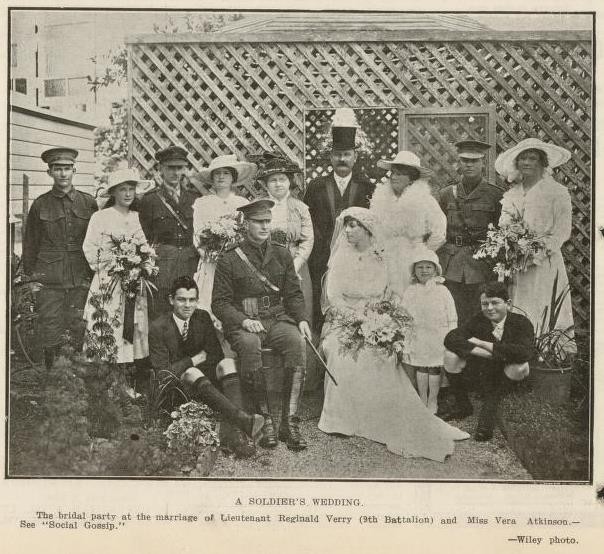
The bridal party at the marriage of Lieutenant Reginald Verry (9th Battalion) and Miss Vera Atkinson
Arriving at Plymouth on 9th January 1917 (the two and a half month sea voyage was via Capetown to avoid German submarines in the Mediterranean) Reg was posted to the Grenade School in Tidworth, where he completed two courses qualifying as an instructor. Reg was posted to the 49th Battalion, the same battalion as James Atkinson, and marched in on the 1st May 1917. The 49th was involved in the opening of the battle of Messines and Reg was promoted to Lieutenant in the field on 14th June.
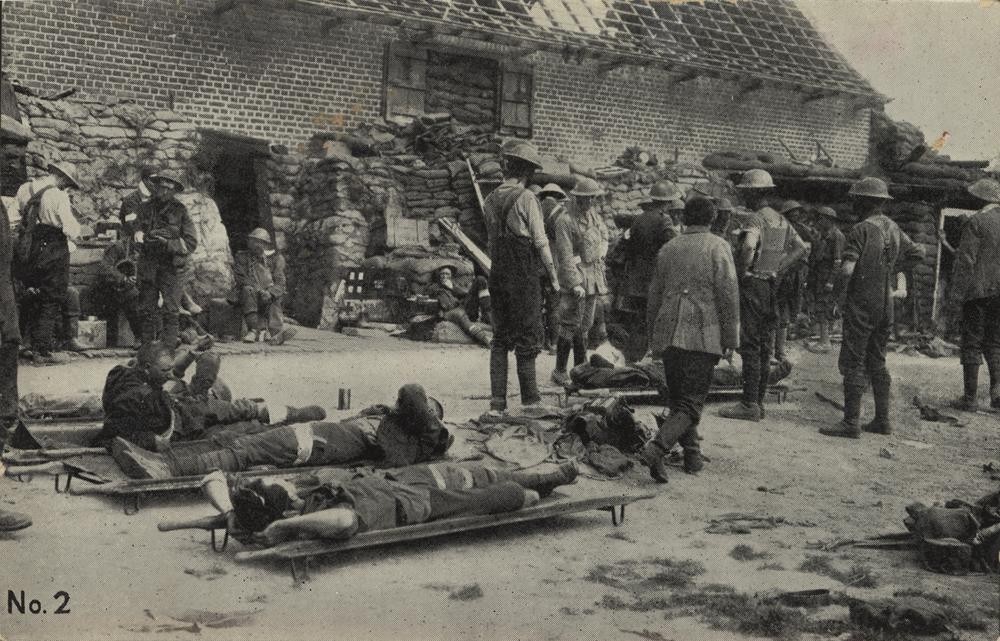
Battle of Messines. Anzac Field Dressing Station scene 7 June 1917, John Oxley Library, State Library of Queensland Neg. 194872
Reg had only been with the unit for a little over two months when he was granted ten days leave in England at the end of July. No reason for the leave is given. On 23rd November 1917, as the front was being closed down for the winter, Reg was posted to an intelligence course for a month before rejoining the battalion in winter quarters in Flanders. Curiously Reg was granted another two weeks leave in England in February 1918, returning to his unit in the middle of March 1918.
On 21 March 1918, Ludendorff launched his final gamble to break the stalemate on the Western Front. The timing was critical as the Germans had a number of divisions available after the collapse of the Eastern Front which were hastily transferred to the Western Front. The operation needed to succeed before General Pershing’s U.S. Forces, which were arriving on the Western Front, could be deployed and swing the course of the war in the German favour. Operation Michael caught the British Forces in the Somme by surprise with the speed and efficiency of the advance and the gains of 1916/17 along the Peronne-Amiens axis were quickly surrendered by Gough’s forces.
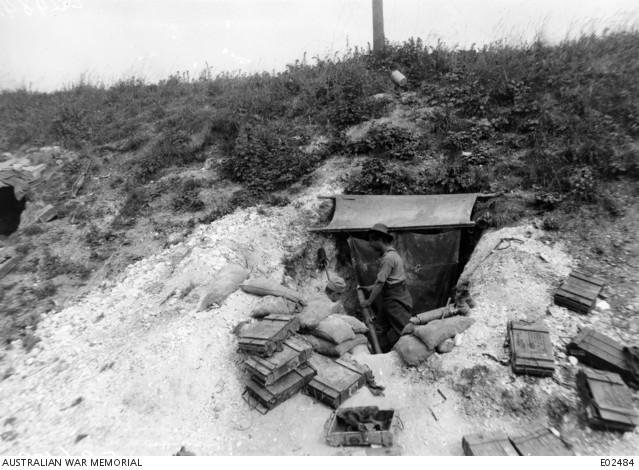
A Stokes mortar gun in action on the railway embankment near the Dernacourt Casualty Clearing Station, the scene of desperate fighting by the 12th and 13th Brigades against four divisions of the enemy on 4 April 1918, Australian War Memorial E02484
To halt the advance, first the 3rd and then the 4th Australian Divisions were rushed into the line at Dernacourt on the Ancre River just south west of Albert. On the 5th April 1918, the 13th Brigade faced one of the heaviest infantry attacks of the war. The 47th Battalion (also part of the 13th Brigade) was defending a railway embankment but the Germans managed to cut them off from the flank support by pouring through a railway underpass. Two companies of the 47th were either killed or taken prisoner. The 12th and 13th Brigades (which were no where near full strength) were attempting to halt 2 and a half German Divisions. At 5:00 pm the 49th along with the 48th Battalion counter-attacked to regain the embankment which was successfully accomplished.
The 49th Battalion war diary records the frantic communication stream passing from Battalion HQ to the various companies as the battle developed. The diary also records that 7 officers and 53 other ranks were killed on 5th April. Both Lieut. Reginald Verry and Capt. James Atkinson were amongst those killed. Official correspondence in Reg’s personnel file records that he was cut down by machine gun fire and died instantly. He was buried in a temporary cemetery near the battlefield.
The notification of Reg’s death was a cause of considerable concern to Reg’s wife, Vera. Because Reg had technically enlisted twice, once as a private in 1914 and again as a 2nd Lieutenant in 1916, there were two sets of attestation papers in his file with differing next of kin. The condolence messages were sent to his mother in Warwick rather than Vera at Cavendish Road where she lived with her father and mother. To verify that she was in fact the proper next of kin, Vera wrote to base records enclosing a copy of her marriage certificate as well as a copy of the birth certificate of her infant daughter, who had been born while Reg was overseas.
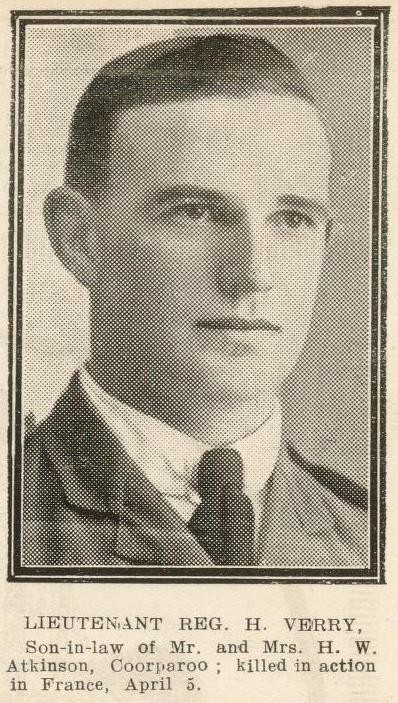
Lt. Reginald Verry, p.28 of the Queenslander Pictorial, supplement to The Queenslander, 5 October, 1918
Reg Verry’s personal effects (which in the case of officers included all uniform items) were packed in a sealed steamer trunk to be despatched to his wife. The baggage was loaded onto the S.S. Barunga in July 1918 along with the personal effects of his brother in law, James Atkinson. Also on board the Barunga was a number of returning wounded and discharged servicemen heading for Australia. On 15 July 1918 the Barunga was torpedoed by a German submarine south of the Scilly Isles. She sank quickly with all cargo being lost but all survivors were rescued. Ironically, the Barunga was previously registered as the Sumatra, and had been confiscated from the German owners by the Australian Government when she was discharging cargo in Sydney in August 1914.
At war’s end, the remains of Reg Verry and James Atkinson were relocated. They both now rest at Dernacourt Communal Cemetery Extension just south of Albert in the Somme Valley. The Atkinson household must have been a sad place in the ensuing years.
After the issue of medals to Reg’s widow, there is no further record of what happened to Vera or her young daughter. No family member applied for the Gallipoli Medallion which was issued on the 50th Anniversary of the landings, and to which Reg was entitled. Verry Street in Coorparoo was named after him as a mark of respect by the Shire.
Comments
Your email address will not be published.
We welcome relevant, respectful comments.